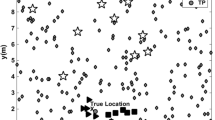Abstract
The location of entities in a smart indoor environments is an important context information. To this end, several indoor localization algorithm have been proposed with the received signal strength fingerprint (RSS-F) based algorithm being the most attractive due to the higher localization accuracy. However, RSS-F based localization accuracy is highly degraded on account of non-line-of-sight (NLOS) propagation in indoor or harsh environment. This thesis proposes an approach for NLOS self-monitoring and autonomous compensation. Firstly, the localization area is regionalized according to Voronoi Diagram. Then, the self-monitoring and autonomous compensation is realized by propagation environment similarity represented by the dynamic path attenuation index between the domains. The verification experiment results show that the proposed algorithms can adaptively identify the NLOS interference and accomplish compensation. Compared with other localization algorithm, the maximum error is reduced from 3.04 m to 1.71 m, the average error is reduced to 0.90 m, and the localization time is reduced to 2.113 s (contain 10 test point) compared with other tracking algorithm.
Access this chapter
Tax calculation will be finalised at checkout
Purchases are for personal use only
Similar content being viewed by others
References
Xiao, J., Zhou, Z., Yi, Y.: A survey on wireless indoor localization from the device perspective. ACM Comput. Surv. 49(2), 1–31 (2016)
Chen, L., Yang, K., Wang, X.: Robust cooperative Wi-Fi fingerprint-based indoor localization. IEEE Internet Things J. 3(6), 1406–1417 (2016)
Kumar, S., Hegde, R.M., Trigoni, N.: Gaussian process regression for fingerprinting based localization. Ad Hoc Netw. 51(1), 1–10 (2016)
Liu, W., Fu, X., Deng, Z.: Coordinate-based clustering method for indoor fingerprinting localization in dense cluttered environments. Sensors 16(12), 1–26 (2016)
Yiu, S., Dashti, M., Claussen, H.: Wireless RSSI fingerprint localization. Sig. Process. 131(1), 235–244 (2017)
Yiu, S., Yang, K.: Gaussian process assisted fingerprinting localization. IEEE Internet Things J. 3(5), 683–690 (2016)
Huang, Y., Zheng, J., Xiao, Y., Peng, M.: Robust localization algorithm based on the RSSI ranging scope. Int. J. Distrib. Sens. Netw. 10(1155), 1–8 (2015)
Chen, Q.Y., Wang, B.: FinCCM: fingerprint crowdsourcing, clustering and matching for indoor subarea localization. IEEE Wirel. Commun. Lett. 4(6), 677–680 (2015)
Hernandez, N., Alonso, J.M., Ocana, M.: Hierarchical approach to enhancing topology-based WiFi indoor localization in large environment. J. Multiple-Valued Logic Soft Comput. 26(3), 221–241 (2016)
Li, J., Tian, J., Fei, R.: Indoor localization based on subarea division with fuzzy C-means. Int. J. Distrib. Sens. Netw. 12(8), 1–16 (2016)
He, C., Guo, S., Wu, Y.: A novel radio map construction method to reduce collection effort for indoor localization. Measurement 94(1), 423–431 (2016)
Pak, J., Ahn, C.K., Shmaliy, Y.S., Lim, M.T.: Improving reliability of particle filter-based localization in wireless sensor networks via hybrid particle/FIR filtering. IEEE Trans. Industr. Inf. 11(5), 1089–1098 (2015)
Chen, G.L., Meng, X.L., Wang, Y.J., Zhang, Y.Z.: Integrated WiFi/PDR/Smartphone using an unscented Kalman filter algorithm for 3D Indoor localization. Sensors 15(9), 24595–24614 (2015)
Tian, Z., Jin, Y., Zhou, M.: Wi-Fi/MARG intergration for indoor pedestrian localization. Sensors 16(12), 1–24 (2016)
Li, L., Yang, W., Bhuiyan, M., Zakirul, A.: Unsupervised learning of indoor localization based on received signal strength. Wirel. Commun. Mobile Comput. 16(15), 2225–2237 (2016)
Zhou, M., Qiu, F., Xu, K.J., Tian, Z.S., Wu, H.B.: Error bound analysis of indoor Wi-Fi location fingerprint based positioning for intelligent Access Point optimization via Fisher information. Comput. Commun. 86(1), 57–74 (2016)
Zhao, Y.B., Fan, X.P., Xu, C.Z., Li, X.F.: ER-CRLB: an extended recursive cramer-rao lower bound fundamental analysis method for indoor localization systems. IEEE Trans. Veh. Technol. 66(2), 1605–1618 (2017)
Ru, J., Wu, C., Jia, Z.: An indoor mobile location estimator in mixed line of sight/non-line of sight environments using replacement modified hidden markov models and an interacting multiple model. Sensors 15(6), 14298–14327 (2015)
Acknowledgment
This work was financially supported by the Science and Technology Commission of Shanghai Municipality of China under Grant (No. 17511107002).
Author information
Authors and Affiliations
Corresponding author
Editor information
Editors and Affiliations
Rights and permissions
Copyright information
© 2017 Springer Nature Singapore Pte Ltd.
About this paper
Cite this paper
Li, A., Fu, J., Shen, H. (2017). Research on Indoor Fingerprint Localization System Based on Voronoi Segmentation. In: Fei, M., Ma, S., Li, X., Sun, X., Jia, L., Su, Z. (eds) Advanced Computational Methods in Life System Modeling and Simulation. ICSEE LSMS 2017 2017. Communications in Computer and Information Science, vol 761. Springer, Singapore. https://doi.org/10.1007/978-981-10-6370-1_30
Download citation
DOI: https://doi.org/10.1007/978-981-10-6370-1_30
Published:
Publisher Name: Springer, Singapore
Print ISBN: 978-981-10-6369-5
Online ISBN: 978-981-10-6370-1
eBook Packages: Computer ScienceComputer Science (R0)




